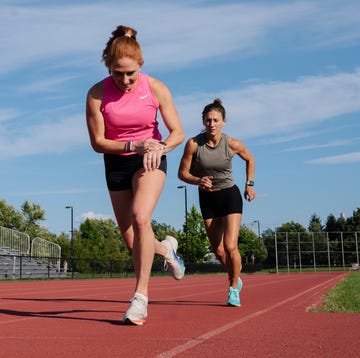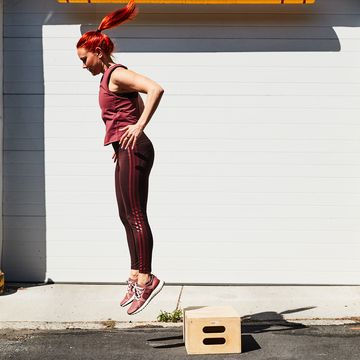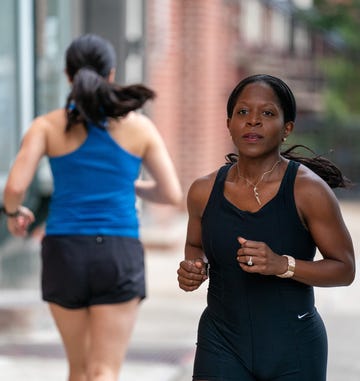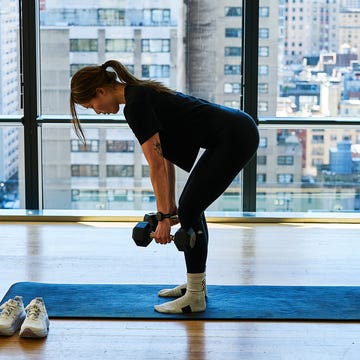Given a choice, most runners use their allotted exercise time to lace up and hit the streets, trail, or tread. Any other workout is often considered a contingency plan for injuries or severe weather conditions. However, there are excellent reasons—icy sidewalks and nagging hip pain aside—for runners to incorporate cross-training into their fitness repertoires.
The cross-training workout you do needs to give you the most bang for your buck, and two of the most popular—and, as you’ll see, most beneficial—are calisthenics and lifting weights. So, when it comes down to calisthenics versus weight training, which one should runners choose?
According to the experts we consulted, both types of exercise offer benefits, but each has its own unique list of selling points. Read on for a deeper dive into each modality and the information you need to make the most of your cross-training.
Calisthenics vs. Weights: What They Have in Common
Both calisthenics—rhythmic bodyweight exercises such as burpees and air squats—and weight training—exercises that incorporate the addition of dumbbells or barbells, or that use bodyweight as resistance—address the need for varied movement patterns. The human body moves in three planes: sagittal (forward and backward), frontal (side to side), and transverse (rotational), but running keeps you squarely in the sagittal plane, explains Grayson Wickham, P.T., D.P.T., C.S.C.S., founder of Movement Vault, a stretching app. “It’s really not even one full plane of motion. It’s only half a plane because you’re not going backward,” he says.
Over time, your joints, muscles, and fascia adapt to what you do most. So, if you lack sideways or rotational movement, you may experience mobility issues, which can lead to problematic movement compensations or a lack of flexibility.
Because both weight training and calisthenics encompass so many different exercises, the modalities counteract running’s limitations. You will move in different directions and broaden your range of motion. When you run, your hips flex and extend a minimal amount, Wickham says. Doing a workout that contains, for example, dumbbell thrusters, multi-directional lunges, and lateral bear crawls increases the amount of flexion and extension in the hips, knees, and ankles, while also engaging the core and upper body. “If you move your joints in a larger range of motion and add more variability to your training, that’s going to make you a more well-balanced and resilient runner,” Wickham says.
Weightlifting and calisthenics also strengthen your muscles, albeit in different ways. Air squats use bodyweight to build strength and endurance in your legs, glutes, and core, while jumping squats—a calisthenics move—also develop explosive power. Squatting with added weight, such as a barbell, promotes hypertrophy, or the increase of muscle mass, and improves maximal strength.
When to Do Calisthenics
Doing calisthenics isn’t better than lifting weights, but there are times when a bodyweight move with the addition of a cardio challenge, such as in jumping jacks or mountain climbers, may more closely align with your training schedule and goals. The next time you schedule a non-running workout, consider the following conditions and see if they apply to you.
1. You can’t run, but crave cardio
From a cardiorespiratory benefits perspective, a calisthenics workout is closer to a run than lifting weights. “Calisthenics are definitely going to increase your heart rate more than a strength-training session, especially if you go from one movement to another without taking a ton of rest in between,” Todd Buckingham, Ph.D., an exercise physiologist at PTSportsPRO in Grand Rapids, Michigan, tells Runner’s World.
A study in Frontiers in Physiology compared the physiological and perceptual responses of high-intensity calisthenics workouts and high-intensity treadmill running. Researchers found the results, which they determined using metrics like blood lactate and rate of perceived exertion (RPE), to be comparable.
Buckingham explains that calisthenics can be helpful when you need or want to take a break from your usual training. “It will be a sufficient stimulus to maintain or at least decrease the amount that your cardiovascular fitness would drop if you needed to take an extended period of time off,” he says.
2. You’re looking for a less intense workout
One benefit of calisthenics is that you can adjust the intensity according to your needs and goals. Plyometric movements paired with a faster pace will offer HIIT (high-intensity interval training) vibes, while low-impact exercises performed at a steady pace and interspersed with regular rest periods can be used to program zone 2 workouts and active recovery sessions.
For a runner who trains hard or skimps on rest, an easy bodyweight session may be more beneficial than weight training. “Even moderately heavy strength training on top of your runs could just totally crush your recovery and send you right off track, from an overtraining standpoint,” Wickham says.
3. You want to be a more explosive runner
Want faster finishes? Easier time running up hills? Improved running economy? Plyometric calisthenics help develop explosive power, which can translate to better performance.
“What is running but jumping from one foot to the other?” Buckingham says. “The more explosive you can be jumping from one foot to the other, the longer your stride length is going to be and, therefore, the faster you’re going to be able to run for the same amount of effort.”
Research shows that a calisthenics workout doesn’t need to be complicated or lengthy to be effective. A study published in Scientific Reports measured the effects of hopping on two feet for five minutes a day for six weeks. Participants, all of whom were amateur runners, experienced significant improvements in their running economy, which means running at high speeds felt easier.
4. You’re new to the gym
Barbells, weight plates, and machines can overwhelm someone new to strength training. But, chances are, you’ve been doing jumping jacks and push-ups since your elementary school P.E. class.
“Calisthenics can be really beneficial for people who may be inexperienced in weightlifting and may feel intimidated to go to the gym,” Buckingham says. Calisthenics allows you to develop strength using your own bodyweight, so equipment isn’t necessary. And if you’d prefer to skip the gym altogether, you can.
That said, calisthenics can also serve as a stepping stone to training with weights. Doing movements like squats, lunges, and single-leg deadlifts sans dumbbells allows you to master proper form so that when you do add additional resistance, you’re lifting safely and effectively.
A Sample Calisthenics Workout
Designed by Raj Hathiramani, these moves will improve your endurance as they combine strength with cardio. Do the sequence once, then repeat.
1. Overhead reach - 10 on each side
2. Sumo squat - 10 reps
3. Reverse lunge to knee drive - 10 on each side
4. Side plank with leg lift - 10 on each side
5. Fire hydrant - 10 on each side
6. Single-leg glute bridge - 10 on each side
7. A-skip - 10 on each side
8. Butt kick - 10 on each side
When to Lift Weights
If you follow a well-rounded training program (and abide by the Centers for Disease Control’s physical activity guidelines), you likely already have a couple of strength-training workouts scheduled during the week. But, when you’re suddenly faced with a canceled run or an unexpected workout window, the following can help you figure out whether or not to do a traditional strength workout with weights.
1. You’re concerned about injuries
Studies have shown that both non-athletes and athletes suffer fewer injuries when they safely strength train. For example, a 2018 systematic review, qualitative analysis and meta-analysis published in the British Journal of Sports Medicine found that a 10 percent increase in strength training volume reduced the risk of injury. The studies included a variety of populations and interventions, and all demonstrated a strong relationship between strength training and sports injury prevention.
That might be because, as Wickham explains, injuries occur “when you subject a tissue—whether it’s a ligament, the meniscus, a muscle, a tendon—to more force than that tissue can absorb. That’s where the damage comes in,” he says. However, when you lift weights, the body’s tissues respond by adapting to that external force and becoming stronger and more stable. “A more resilient joint is going to be able to withstand more,” Wickham says.
2. You’re trying to increase (or maintain) muscle mass
Research indicates that lifting weights is the most effective way to promote the three factors associated with hypertrophy, or the enlargement of muscle tissue: mechanical tension, metabolic stress, and muscle damage. So, whether your goal is to get stronger, change your physique, or stave off sarcopenia (age-related muscle loss), resistance training, along with adequate protein intake and sufficient recovery, is critical to maintaining and increasing muscle mass. By the way, just because muscles get bigger doesn’t mean your overall body size gets bigger. Muscle is more dense than fat and so takes up less space.
And a head’s up on sarcopenia: it starts sooner than you may think. Onset varies from one person to the next, but medical literature indicates that you can begin to lose muscle mass as early as the “fourth decade of life,” a.k.a. your 30s. So, even if you’re relatively young, it’s a good idea to establish a strength-training practice now and get ahead of the potential problem.
3. You slouch, and your arms get tired when you run
Strong glutes and legs are great, but if everything from your waist up is weak, your form and performance will suffer.
Buckingham sees this in runners who, halfway through a run, start shaking out their arms because they’re fatigued. “Then their traps [shoulder muscles] get all tight because their arms start to get heavy, so they’re trying to lift up with their traps,” he says. From there, it's a chain reaction that can hijack your posture and wreck your alignment and mechanics.
Weight training the arms, shoulders, back, chest, and core is an effective way to strengthen the upper-body muscles and make them more resistant to fatigue. You may also experience better balance, increased speed, and more running efficiency thanks to a more powerful arm swing.
4. You want to be a more explosive runner
Yes, “developing explosive power” is also included in the reasons to do calisthenics, but lifting weights is yet another way to increase speed and efficiency. It’s good to have options.
In addition to creating stronger muscles that generate more force, weight training fine-tunes your neuromuscular system, Buckingham says. He likens the connection between the brain and the muscles to a complicated maze. Your first few attempts at getting from point A to point B include dead ends and wrong turns, but the more times you run the maze, the fewer deviations you make and the faster you get.
“So, as you strength train more and more, your nervous system becomes more and more adept at only recruiting the muscle fibers that need to be recruited, instead of wasting energy by recruiting a bunch of muscle fibers that don’t need to be recruited,” Buckingham says. The result is faster, more energy-efficient running.
A Sample Weight-Training Workout
These nine moves will make you a stronger runner and are perfect for the cross-training days on your race plan. For each move, begin with a weight you know will be too easy, then, after you perform 3 sets of 10 reps, if the move is still easy, begin with a heavier weight the next time you do the workout. You can do this 2 to 3 times a week.
1. Push-up
2. Bent-over row
3. Reverse fly
4. Plank
5. Leg raise
6. Single-side weight sit-up
7. Deadlift
8. Lunge
9. Single-leg glute bridge
The Final Word: Calisthenics vs. Weight Training
The good news is that there isn’t a wrong choice between calisthenics and weight training; both will complement your running and help you become a more well-rounded athlete. Having a clear understanding of your goals, fitness and experience levels, and schedule can help you choose a workout that will give you the best bang for your buck. If you have the time, do both!













